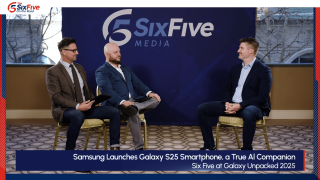On this episode of The Six Five On AI, hosts Daniel Newman and Patrick Moorhead welcome Walter Sun, Global Head of AI at SAP for a conversation on SAP’s AI strategy.
Their discussion covers:
- An overview of SAP’s AI strategy
- What makes SAP different from other existing language models in the market
- What challenges customers are facing and how SAP’s products and services are helping customers overcome those challenges
Be sure to subscribe to The Six Five Webcast, so you never miss an episode.
Watch the video here:
Or Listen to the full audio here:
Disclaimer: The Six Five webcast is for information and entertainment purposes only. Over the course of this webcast, we may talk about companies that are publicly traded, and we may even reference that fact and their equity share price, but please do not take anything that we say as a recommendation about what you should do with your investment dollars. We are not investment advisors, and we ask that you do not treat us as such.
Transcript:
Patrick Moorhead: The Six Five is back and we are here talking about our favorite topic, bestie, and that is AI.
Daniel Newman: AI.
Patrick Moorhead: Yes, I know. Can you believe it was a year ago we were on the West Coast going through this new flavor of AI called generative AI? But heck, AI isn’t new. Algorithms started in the ’60s. We had analytics-based AI, went to machine learning, deep learning and generative AI. But 2023, what happened then, Dan?
Daniel Newman: Yeah, it was, what about November ’22, our entire world got shook. In ’23, it was just like strapping a rocket pack to this trend line. And there’s always those sort of moments, tipping points, crossing the chasms, whatever you want to refer to them, that technology goes from being something that is understood or in some cases even nascent to being highly commercialized. And so, over the past year, we have seen the market absolutely take this on as the really one and only thing. But you and I have talked a lot about this, whether it was at Davos, CES, whether we’re heading to MWC, or just these enterprise conversations that we have, pat, that it is a and not an or. And that AI is something that’s being coupled closely with a lot of the other technologies that we’ve long covered, whether that’s cloud, whether that’s big data analytics, whether that’s cybersecurity. And Pat, there are just some people out there that could really help us that have great insights and that’s why we do The Six Five On AI.
Patrick Moorhead: That’s right. And when the real magic happens with companies, our very important systems of record transactional systems and ERP is a core part of that. It is literally the foundation of what companies run their businesses off of, customer information, manufacturing information, distribution information, getting paid, paying other people, very important things. That’s a great segue. I’d like to introduce the head of AI for SAP. Walter Sun, great to have you on The Six Five. First-timer.
Walter Sun: Yes, indeed. Thank you Pat and Daniel for having me on. Glad to be here.
Daniel Newman: Yeah, the whole time I was kind of doing the preamble, I was thinking, “We have someone really well-versed with a background both academically and professionally that could probably fill in a lot of blanks for us here. Not to mention someone that’s been in this field studying it for quite a long time.” I remember I did one of these interviews with someone and they were telling me how in 1994 they did their PhD in AI, in some flavor of that. And you’re thinking to yourself, these emerging technologies, they really aren’t as instantaneous as the market likes to lead us to believe. They do happen over time and there are people like yourself that have been studying it a long time, like you did at MIT. But I don’t want to steal the thunder of your introduction. I guess first and foremost, global head of AI at SAP. Give us just the quick background and what does global head of AI at SAP do every day?
Walter Sun: Yeah, absolutely. So, I lead and oversee the product engineering team of AI at SAP. So, which means that we build AI capabilities, which are leveraged by different lines of businesses at SAP, as well as publicly by our enterprise customers as well. And so the job of my organization and myself is to build both the vision and the strategy and also the execution of the technology, so that people can actually use features. For instance, we built our business OCR capability, which is used in a lot of different scenarios in SAP because a lot of people have analog information that they need to digitize. They need to actually understand what’s on it. So, that’s just one example of technology we built. But now, as you mentioned, people both are talking about generative AI is top of mind, and we’re adding a lot of that sprinkled on top of like you said, and versus or, we’re not just removing the narrow AI. Something like OCR is very specific and does very, very well for certain scenarios, but there are other scenarios where adding generative AI can compliment. And so, we’re doing that in our technologies.
Patrick Moorhead: That’s good. You got a good job there. I might need to make an introduction to my son who does AI. But anyways, I think a great place to start the conversation is maybe giving an overview. What is SAP’s vision for AI? It’s not the first time that you’ve done AI obviously, but what is the overall vision that really guides and directs everything that gets done?
Walter Sun: Yeah, thanks for asking, Pat. So, SAP’s AI vision is to help the world run better and improve people’s lives by leveraging artificial intelligence technology. So, we run business applications from many of the world’s largest companies. And this happens behind the scenes, so people might not realize this, but providing this strong AI into our offerings is very, very important and key to our customers, I think. And so, our ambitions is to make SAP the market leader in business AI by 2025. And we want to measure this by customer adoption and we want to set the standard for trustworthy business AI. Our mission is to accelerate the adoption AI to generate good business value. So, not just shipping a bunch of little features, but looking for value drivers that can create financial value to our business customers.
And so, a big part of this, as we talked about earlier, is leveraging generative AI technologies. We’ve created this digital assistant we call Joule, which leverages large language models and allows for a natural language conversation with business users to get things done. And we have a generative AI hub, which is the offering inside of our business technology platform, which allows developers in the SAP ecosystem to create using large language models in a way that we abstract the decision making or model choice, content moderation, filters and other components. And so, we still provide the transparency, what we choose. We make it easier for our customers by recommending the model which works best at the most efficient cost.
Daniel Newman: And I like that you use the word business AI. Because I think with 2023 being so hyper-focused on these consumer use cases, these killer apps, it’s very easy to sort of conflate. We remember the earliest days, Walter, of people using the LLMs, and you heard about one major Korean conglomerate where the people were putting their strategy in. And I think even this week, I know you’re giggling because it’s silly, but it’s kind of like people that got hacked because they left a sticky note with their password on their government-issued PC. But people were sort of making this assertion that this was the catchall and be all for all things business.
And the truth is that what businesses need from AI hasn’t changed as much as we think just because of the advent of generative text or generative imagery. You still need well-managed data, you still need the systems of record, you still need the applications that can thoughtfully take into consideration the right variables. And you need all these things to really tie together intelligently, which creates the need for strategy. And so, you mentioned your vision, which is great, but when it comes to taking that vision and turning it into strategy, I’m hearing business AI. How do you put a strategy into market that people understand and then maybe start to really look at SAP as the biggest player in this particular space?
Walter Sun: Yeah, I think one good thing you mentioned, Daniel, is how 2023 is a year of consumer generative AI. You try things out, it’s creative, it’s fun, but maybe 100% accuracy might not be required. You mentioned the word business. When you talk about business AI, businesses need to be much more accurate, and so our technology needs to be accurate and there are ways to use grounding and context setting to do better. So, at a high level, SAP’s business AI strategy is to infuse this AI into applications and business processes. The strategy has three pillars. One is to embed AI into applications. So, AI needs to be an integral feature that increases the value of SAP’s SaaS applications through automation, natural human machine interactions and insights.
And so, for instance, we’ve developed and delivered generative AI capabilities into our SuccessFactors, human resources product, where we use AI to help managers and recruiters create job descriptions automatically and to help employers and employees actually find personalized learning recommendations. And second pillar is to expose business-centric AI services for extensions like SAP’s Business Technology Platform. We don’t compete in building large language models, but rather, we offer the same targeted generative AI services for custom extensions that are used to power AI features natively embedded in our SaaS applications, including hosting and management. And the third part is building capabilities to scale business AI to ensure customers have the trust of what we’re building. So, trust not only includes ethics and data privacy, but also, full governance, lifecycle management and product standards that customers expect from SAP, along with fairness in the algorithms and explainability of results and transparency in the full process.
Patrick Moorhead: No, that’s good. So, pretty good understanding of the vision. Talked a little bit about the strategic elements of that. Let’s talk about, and I know this might be hard to classify because you’re solving so many different kinds of problems across so many different types of systems, but what problems are you solving? I mean, is it classic, do the same with less? Do more with the same? Speeding time to decision? How would you classify the problems that you’re solving?
Walter Sun: Yeah, so you’re right, there’s a wealth of business problems we can help solve. I think one is choosing the right product or services from a large set of options. AI can look and analyze customer data to offer personalized recommendations and targeted marketing campaigns. That’s one area we’re working on. Long wait times, you mentioned the delays, long wait times or inadequate customer service. I think one of the beautiful areas of generative AI is the ability to increase deflection rates. So, we have AI-powered chatbots and virtual assistants, and they can handle customer inquiries more than they did before, and so they deflect from going to humans. And you provide instant support, reducing the human intervention and reducing the average handling time, in turn means smaller hold time for customers.
So, enterprises are happy because they get more efficient, effective employees, but customers are also happy too. It’s a win-win because customers… You and I have been on phone calls with airlines, for instance during a pandemic, where wait times were eight, 10 hours, change that to 15 minutes when you want it, right? So, that’s one area which I think is a win-win for everybody. Inventory stockouts or excess inventory supply chain space. I think analyzing historical data, consumer behavior patterns, this time series model. But we can add exogenous signals. For instance, now you know pandemics can happen, Suez Canal blockages can happen. Different things can happen, which you couldn’t have predicted.
But using AI to do what-if analysis. Hey, here’s 15 different scenarios that can happen. A pandemic, it could be a weather-related issue in different parts of the world, different parts of the country. And once you have all these different what-if analysis done, you can actually have a good forecast of demand from each scenario. And as soon as something bad happens or something unfortunate happens or unpredicted happens, you actually have the what-if analysis already. So, it’s actually predictable unpredictability, if you will, so that way you can react more quickly. Another big area is combating fraud and protecting customers of financial loss. So, AI algorithms that look at large volumes of data, detect patterns, anomalies of frauds and activity and transactions. And that’s also very valuable for our business customers.
Daniel Newman: Yeah, there’s a lot of challenges. It’s almost an unfair question to ask, Pat.
Patrick Moorhead: I know it really is.
Daniel Newman: Abundant and to SAP’s credit, the business AI, I like so much for SAP because you have done such a good job of fragmenting or demarcating your industries. We’ve worked for a long time with the company and we know the granularity by which your industries go. And the granularity is because the work is very different, the problems are very different. So, the problems for a mill and mining company versus a media and technology company versus a manufacturing company are all different. And having said that, yet, some of them are the same and that’s the interesting thing.
All companies want to understand attrition and what keeps a customer, but the attrition in a specific industry is different, so the regression models or the way you would end up figuring that out is different. And so, that’s where AI can be very helpful and it can create all kinds of productivity and speed. So, you say business AI, you say digital assistants. What are the offerings? If someone’s like, “Okay, Walter. I want to buy a lot of AI from SAP,” what are they buying from you? What is that exactly?
Patrick Moorhead: I’d like some Joule with a side of… I don’t know, SuccessFactors.
Daniel Newman: Two bundles of AI.
Walter Sun: Two bundles? You’re right, Daniel, you mentioned mining and forestry and other areas. I mean, SAP offers a wide range of AI-powered scenarios built into its business processes. And so we connect finance, supply chain, procurement, sales, marketing, human resources and IT. And so, all of these scenarios, AI are already embedded into all of our applications. And on top of that, we’re offering targeted products for customers to create custom extensions through our SAP business technology platform, which allows developers to build within our ecosystem. But one of the parts you mentioned, I think I mentioned Joule. So, Joule is our digital assistant, and the goal for Joule is that you can just chat with Joule. So, let’s say you’re a new employee at a company that uses SAP, which is quite likely given the reach we have around the world.
Instead of knowing like, hey, I need to go to SuccessFactors to open a new requisition, I need to go to our CX tool to find our CM information, or I need to go to S4 cloud ERP to find supply chain. I can ask questions with natural language saying, “Hey, look, I want to create a new job description for an intern I want to hire this summer.” And then, that takes care of it. It opens SuccessFactors, and does what it does needs to do. I want to look at my coworkers. Let’s say you hired me in as a sales executive. I want to look at some of my sales employees and what their top leads are. And instead of having to know to open CX, open the application, find out where to find it, it just responds to you. It’s almost like having a virtual human assistant that actually knows the product. If I joined SAP and there’s an employee who’s been around for 30 years who knows everything, I can say, “Can you just help me do X, Y, and Z?” And that’s what we want to do for all of our business customers.
Instead of saying, “Hey, spend a month or two learning all of our SAP applications…” And obviously, the experts and professionals will want to do that to be able to be super efficient. But for the newcomer, for someone who doesn’t use every application every day, how do we use natural language through Joule to communicate? And our vision is to build that out across all of SAP’s offerings. And then, in addition, every company has its own custom offerings. And so, then, well, it’s not really interesting to use Joule for some things, use a different assistant for something else, use a different search engine for something else.
We’re building extensions, that we’ll talk about later this year, where you can actually build your own custom connectors and build your data into Joule, so that if I’m asking a question about SuccessFactors, it goes there. But if I’m asking a question about your own, let’s say travel agency, it goes into your travel agency and finds information. So, there’s ways to kind of go around and have your own custom applications built in, so that we can become more sticky and more user-friendly, if you will, for our business customers. So, we can just use Joule to do everything.
Patrick Moorhead: Yeah. And the more places you could put Joule, the better the outcome. And I think we might get in a day where you’ve got battling AI, I don’t know what you would call them, chatbots. Like who gets the ball, right?
Walter Sun: Exactly.
Daniel Newman: So, Pat, I want to just ask Walter this before you move on. But Joule as a unit of energy, Joule as… Come on. What’s the thinking? I think Google renamed theirs because Bard was kind of odd, to Gemini. Joule’s cool, but you guys haven’t really talked about it. Was it what I said? Is it kind of the energy? What drove that naming?
Walter Sun: It’s a good question. I mean, I didn’t come up with that name, but the smart people who did think about Joule as an energy source and consumption of energy. And so, it is like how do we bring energy to people and empower them? And so, you’re talking about, Pat, about the battle of chatbots. I mean, the reason why I think that I mentioned extensions as kind of a near-term story and then in the future, maybe even offering some small consumer extensions that make it more usable, like you can add weather and traffic, other things, which typically companies are starting in consumer space will extend in the enterprise to become the one-stop shop.
We want to think about Joule as a one-stop shop as well. So, we want to make it as extensive as possible so that people aren’t, like Pat was saying earlier, I got to pick four or five different chatbots or whatever. Find one in itself. And yeah, Daniel, I think it’s a great question. I mean, I do think our intention of naming it Joule is to make you think about this is kind of a powerful engine for you to get your work done in business applications.
Patrick Moorhead: Yeah, you can probably guess the next question that’s coming here after we’re talking vision, objectives, strategy and problem solving and products is, okay, well, how are you different? And of course you’re unique because you’re solving business problems, but you have some high-profile large competitors, small upstarts, who are always going after the space. How is your AI different? How do you distinguish whose AI offering is better?
Walter Sun: Yes. So, I’ll first say SAP has been in the business application space for over 50 years. And because of that, besides the know-how, which we obviously tout, we also have the data. And so, SAP has the most important data that powers many of the biggest companies worldwide. And we’re the only ones I think that with the deep expertise. And so, the idea of combining all this process data, our best practices and then power of large language models to ground and input data to create the best creative, yet accurate output is kind of how we add value. And so, for some consumer scenarios, you can think about how generative AI can creatively generate images and texts, which aren’t necessarily 100% factual, but it’s very entertaining. In business scenarios, as I think we talked about a little bit earlier, is that SAP is grounded in the truth of customer’s business, their data, their information.
And we leverage that context with real time information, as I mentioned like the alerting of in a supply chain space. So, looking at anomalies or things that have happened around the world, like news, there’s a Suez Canal blockage, whatever, all that information, bringing it all together to create accurate outputs and bringing out relevant insights to the business customer. And so, the data itself, we actually deal with it in a privacy compliant way of course. But we actually have access and we remove PII, but we can use that data to help train models and focus on answers and solutions which are very specific to your business and not generic to that user.
Patrick Moorhead: It’s interesting, most people always, why my widget’s better than the other widget, you went straight for the data. That makes sense. And with your data cloud, with the integrations and the historical data, it would be hard… Once you put that data to work… And again, it’s been very hard up to this point to make 20 years of data activate that because it’s expensive to go after something. And I remember the days when you would put a relational database query in, and 17 minutes later I would get my answer back. And I know that that was 1994, but this much data, it wasn’t even that much data. So, that makes sense to me. Dan, what do you think?
Daniel Newman: Yeah. No, I think it’s really interesting. I think you were even a little humble there, Walter, because I think one of the areas that you could really double down too is several hundred thousand customers wanting native AI capabilities in the applications they already depend upon to run their business. I mean, look, you can spin that up a couple of different ways because you could say that there’s the born on cloud and cloud native and nouveau, but there’s also like look, companies have stuck with and they move slowly and they modernize. It’s not always modernizing… It’s not laggard, it’s what you need. It’s always that whole idea that business… What’s the right word? Businesses don’t buy technology to solve technology problems, they buy technology to solve business problems. So, it’s about aligning and implementing technology at the right point in time. And so, if you can layer AI right on top of your trusted existing system of record. It’s very, very powerful.
Now, I want to wrap up with a question that I sort of alluded to earlier, and I think you did too, Pat, and actually, we’ve all talked a little bit about this, but is the business foundation model. The business foundation model is different than just the extremely large language models, the trillion plus parameter type models that everyone’s talking about. And these really do align with those 25 industries, with those unique business use cases. Talk about how you explain the differentiation and how you apply this capability to be sticky with your customers and grow your business and keep them on the platform.
Walter Sun: Yeah, thank you for asking. So, data are the fuel for AI, building AI models. And so, to get the most value from AI in our core business areas of finance, supply chain, models need to understand the business context. And so, as you mentioned, large language models don’t have the understanding that most business data is necessary. A lot of this data is proprietary. So, SAP has access to vast amounts of customer data as we just talked about the prior conversation and in a compliant and PI scrubbed way. But the idea is that large language models do a great job understanding how language works and communicating. And the reason it’s possible is because it’s trained on the public web. Everyone’s communicating on the web, so there’s a lot of free information that can be used to train models.
On the other hand, people’s transactions, your purchases at the stores today or last week, you don’t have that public and the businesses you shop at don’t make that public. So, that information isn’t just train up on the web. So, what we did is we’ve actually worked with companies, got permission and access to anonymize and privacy-compliant business data. And this is like we call tabular data. So, for those of you not in the industry, tabular data would be like transactions. I make 10 purchases and each purchase at a store is a dollar amount with line items. So, it’s not language. It’s not language in the sense that you and I are talking, it’s more like $8.25 item code seven, $6.22… And so that’s not a… A language model is like, “I can’t speak that language. That’s a business language.” And so, we’re actually using that as an analogy to human language, and it fits really well in case you’re wondering.
Large language models are built to predict the next word and then the next sentence and then the next paragraph if you will. And so, it’s almost like taking my transactions and say, “What’s Walter’s next purchase? What’s Walter’s next purchases in the month of February? What’s all purchases in 2024?” So, you can sort of see the analogies where we’re building a model that does predictive analytics, if you will, for business data and is trained on business data. And so, because SAP has access to large amounts of business data across many different industries, we can build this proprietary foundation model on business data. The good news also is the technology’s based off of transformer-based technologies, which are the same use for large language models. So, all of the work that everyone’s done publicly and research published and shared for large language models applies to business foundation models as well. So, we can leverage all that knowledge where our team builds this.
Furthermore, they’re complimentary, meaning that I can use this business foundation model to make the prediction, time series prediction or forecast, and then use a large language model to make that answer human-readable. So, now I say, “Here’s Walter’s seven transactions. Predict Walter’s next purchases for the next month. Propensity to buy, propensity to churn,” whatever. And now, once you have that answer, you can actually give a large language model this information and say, “Hey, send this out in a human-readable format for the executive to read.” So, it’s kind of a win-win situation where we, as I mentioned earlier, our business model and AI isn’t to build large language models, we’re leveraging other models because they’re already out there. But instead, we’re building a foundational business model. And that model is meant to understand, do time series forecasting, do demand forecasting, do delay predictions, supply and demand analysis.
And that information, as I think you mentioned earlier, I think talking about different areas that SAP’s kind of working on, we actually have put a model horizontal enough that we can actually give it what we call a couple of few shot learning or basically examples in different areas and say, “Hey, these are tax forms. Can you create a tax form for me? Hey, these are forestry records. Can you do something area of forestry from me? Here are a few examples of transactions in a different country, let’s say in Germany on educational records. Can you build something for me?” So, in other words, the same way you prompt a large language model to solve a lot of different problems with NLP to anything else in that space, you can actually do the same thing in business models where you have a horizontal model that can solve a lot of different problems individually.
Daniel Newman: Yeah, that’s great, Walter. The explanation I was thinking, as you were saying, it is really about, again, this theme of and, the theme of and. It’s not one model. It’s not a one model wins them all. It’s kind of like one architecture with chips doesn’t win them all. We found out one cloud will not win them all. There’s not one business application that will ever rule them all. I mean, of course SAP likes to have its biggest share of the pie, but the point is every company’s running multiple things, multiple… The models are going to be the same way, and there’s going to be that kind of cascading largest and smaller and foundational and micro. And I think we’re just at the very, very beginning. And that was a great explanation, Walter. Go ahead. Did you want to get something in? Because I’m going to shut you down after this.
Walter Sun: Okay. I’ll just say, as I mentioned, you’re absolutely right. So, instead of having to build narrow models, which we have today, which work really well for businesses. We have predicting invoice days, sales volume, supply chain disruptions, and other business scenarios, we hopefully can use a single model and scale out more quickly. So, in other words, we can actually ship out a lot of different AI models as a differentiator to kind of how we can help our customers. We can say, “Hey, a new scenario comes out, or new tax laws come out in different country.” I mean, if you have enough data across all the world, you can actually build it out. If you only have, let’s say data from one country in the US and let’s say German tax laws change, then you can’t just use that model. But the hope is that we have this generic model that can apply across all countries in a wealth of business application scenarios.
Daniel Newman: Well, we’ll be definitely tracking what you’re doing here, Walter. That’s our job as industry analysts is to pay attention to what all the biggest players of the up and comers are doing in this space. The established relationships and trust that SAP has built is palpable, substantial in the industry. And of course, there’s always competitors that are trying to find their way to add value, and that’s what makes the world go round. And it’s really, really interesting. But I just want to say thank you so much for joining the show and taking some time and explaining this. I’m sure there’s lots of people out there that we’re genuinely curious kind of how a company as instrumental to business applications as SAP is how you’re approaching AI. So, let’s have you back sometime soon and keep up the good work.
Walter Sun: Thank you, Daniel. Thank you, Pat. I appreciate the time. Enjoyed the conversation today. Thanks.
Patrick Moorhead: Thank you.
Daniel Newman: All right, everybody, hit that subscribe button. Join us for all of the episodes here on The Six Five. This is The Six Five On AI, our special series that focuses on the industry and enterprise companies building AI solutions. For more, got to hit that subscribe button one more time. All right, we’ll see you all later.






















































































